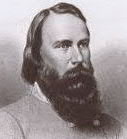Gil R.
Posts: 10821
Joined: 4/1/2005
Status: offline

|
Here's the bio. I had to shorten it, but didn't remove anything of substance, and added that little bit about what he did between commanding the ANV and AOT. Very nice job getting all of the essentials into such a short amount of space.
Gen. Joseph Eggleston Johnston (b. 1807, d. 1891). Johnston was born in Farmville, Virginia, and graduated from West Point in 1829. After serving eight years in the artillery, he was transferred to the topographical engineers. During the Mexican War, Johnston won two promotions and was wounded twice. In June 1860, he was appointed Quartermaster General of the U.S. Army and promoted to brigadier general. But when Virginia left the Union, he resigned his commission – the highest-ranking Army officer to do so – and offered his services to the Confederacy, and was put in command of the Army of the Shenandoah at the rank of major general. At the Battle of First Bull Run, Johnston brought his army to combine with that of Gen. P.G.T. Beauregard, but he ceded direction of the battle to the junior general since he was unfamiliar with the terrain. That August, Johnston was promoted to full general, but he was not pleased that three other men – Samuel Cooper, Albert S. Johnston, and Robert E. Lee – outranked him, when he had been the senior officer to leave the U.S. Army. This led to bad blood between Johnston and Pres. Jefferson Davis that would last throughout the war. Placed in command of the Army of Northern Virginia, Johnston led it at the start of the 1862 Peninsula Campaign, employing a strategy of gradual withdrawals towards Richmond before finally attacking. The Battle of Seven Pines, as it came to be known, was tactically a draw, but it stopped the advance on the city. More significant, however, was that Johnston was wounded so severely that he had to be replaced. Lee’s subsequent successes precluded Johnston’s return to his previous command, so instead he was given a position coordinating operations in the western theater. After the disastrous loss at Chattanooga in November 1863, Davis reluctantly relieved his old friend Gen. Braxton Bragg of command of the Army of Tennessee and replaced him with Johnston. Faced with Gen. William T. Sherman’s advance towards Atlanta in the spring of 1864, Johnston reverted to his strategy of withdrawal. He conducted a series of actions in which he prepared strong defensive positions, only to see Sherman maneuver around them, causing him to fall back towards Atlanta. Johnston saw the preservation of his army as the most important consideration, and hence conducted a very cautious campaign. He handled his army well, slowing the Union advance and inflicting heavier losses than he sustained. On June 27, Johnston defeated Sherman at Kennesaw Mountain, but the defensive victory did not prevent Sherman from continuing his offensive. Despite the victory, Davis became irritated by Johnston’s strategy and removed him from command on July 17, 1864. His replacement, Gen. John B. Hood, was overly aggressive and ineffective, and lost Atlanta in September – making Davis's decision to remove Johnston was one of the most controversial of the war. As the people became increasingly concerned about Sherman’s “March to the Sea,” they demanded Johnston's return. Appointed to command what was left of Hood’s army and other forces in the Carolinas, Johnston on March 19 was able to catch a portion of Sherman's army by surprise in the Battle of Bentonville, briefly gaining some tactical successes before superior numbers forced him to retreat. After learning of Lee's surrender, he surrendered his army to Sherman on April 26, 1865, near Durham Station, N.C. My encyclopedia says that Davis reluctantly gave Johnston permission to negotiate a surrender, so I left out the bit about Davis opposing it. Johnston, like Lee, never forgot the generosity of the man he surrendered to. When Sherman had died, Johnston was a pallbearer at his funeral, keeping his hat off as a sign of respect in the cold, rainy weather. Asked to put on his hat because of the elements, the elderly Johnston replied, "If I were in his place and he standing here in mine he would not put on his hat." Johnston caught pneumonia and died several weeks later, and was buried in Greenwood Cemetery, in Baltimore, Mississippi. (Bio by Scott Jennings)
|
 Printable Version
Printable Version









 New Messages
New Messages No New Messages
No New Messages Hot Topic w/ New Messages
Hot Topic w/ New Messages Hot Topic w/o New Messages
Hot Topic w/o New Messages Locked w/ New Messages
Locked w/ New Messages Locked w/o New Messages
Locked w/o New Messages Post New Thread
Post New Thread